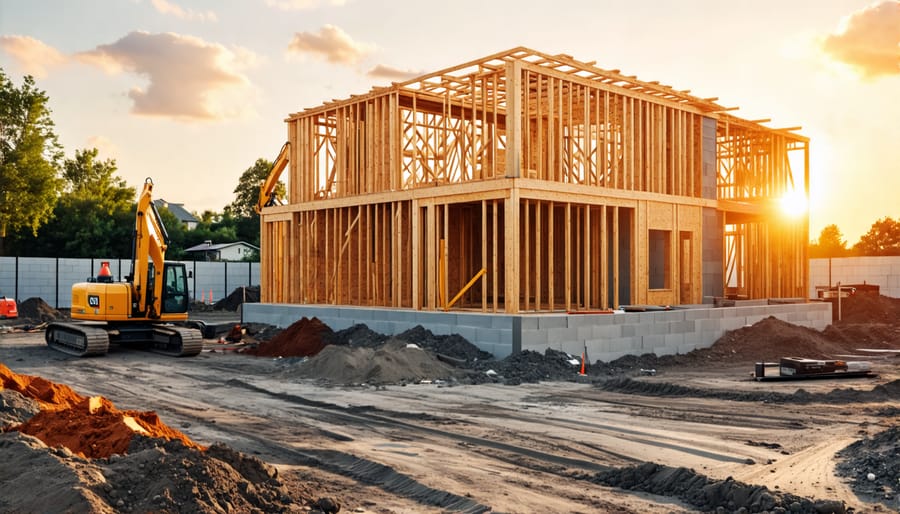The housing market faces a pivotal juncture in 2023 as key trends converge to shape the landscape for buyers, sellers, builders and investors. Spiking mortgage rates stand out as the preeminent force guiding market dynamics this year. The average 30-year fixed rate vaulted from 3.2% at the start of 2022 to over 7% by October, radically altering affordability calculations for prospective buyers. This sharp reversal from pandemic-era record lows sent shockwaves through the market, as many buyers retrenched to the sidelines and transaction volumes plummeted. Dwindling housing inventory exacerbates the affordability crunch. Despite moderating price growth in recent months, the for-sale supply remains near historic lows. New listings coming to market declined year-over-year throughout the second half of 2022 as potential sellers grappled with an unappetizing mix of eroded equity, higher mortgage payments on their next home, and economic uncertainty. With demand still outpacing supply, especially at entry-level price points, the path to a more balanced market remains elusive. Builders confronted their own unique trials in 2022 as the perfect storm of soaring input costs, supply chain bottlenecks, and waning demand wreaked havoc on construction pipelines. Housing starts peaked mid-year before retreating as builders slammed the brakes to shrink backlogs and adapt to the new reality of higher rates suppressing buyer traffic. While most forecasts point to tepid homebuilding activity in 2023, the long-term structural deficit in housing units nationally still presents opportunities, albeit laden with risk and uncertainty. Underpinning these trends are seismic demographic shifts poised to remake housing for years to come. Millennials, the largest living generation, continue aging into prime homeownership years while baby boomers increasingly seek to downsize. This tug-of-war between first-time buyers and retirees over limited affordable inventory epitomizes the generational collisions taking place. Meanwhile, pandemic-induced migrations to secondary cities have yet to fully unwind, suggesting sustained relative strength in these markets even as coastal hubs regain their appeal. Navigating this complex web of forces will define success in the 2023 housing market. While headwinds undoubtedly persist, pockets of opportunity remain for those positioned to capitalize on the unique trends shaping today’s residential real estate landscape. By understanding these key drivers, market participants can chart a course to achieve their housing goals in the year ahead.


Inventory Inches Up
As the housing market cools from its pandemic-fueled frenzy, a silver lining is emerging for potential buyers: a gradual increase in available homes for sale. According to recent data from the National Association of Realtors (NAR), housing inventory is slowly but steadily climbing, providing a glimmer of hope for those who have been frustrated by the severely limited options of the past two years. In June 2022, total housing inventory reached 1.26 million units, up 9.6% from the previous month and 2.4% from a year ago. While still below pre-pandemic levels, this uptick in supply is a welcome sign for buyers who have faced intense competition and rapidly rising prices due to the inventory crunch. Several factors contribute to this trend. Firstly, as mortgage rates rise and buyer demand cools, some sellers are becoming more motivated to list their homes before the market shifts further in favor of buyers. Additionally, new home construction is picking up pace, with builders focusing on more affordable entry-level homes to meet the needs of first-time buyers. However, experts caution that the road to a balanced market will be gradual. Lawrence Yun, NAR’s chief economist, notes that while the increase in inventory is promising, “supply remains historically low and is still a significant challenge for would-be buyers.” He predicts that it may take a few years for inventory levels to fully normalize. Nonetheless, the uptick in available homes is a positive development for the housing market. As more properties come online, buyers may find themselves with more options and negotiating power, potentially leading to a more sustainable and accessible market in the long run. Industry professionals should keep a close eye on inventory trends in the coming months, as they will play a crucial role in shaping the future of the housing landscape.
Builders Hit the Brakes
Material & Labor Challenges Persist
The construction industry continues to face significant material and labor challenges that are hindering its ability to meet the growing demand for new housing. Supply chain disruptions, stemming from the COVID-19 pandemic and other global events, have led to shortages and price increases for essential building materials such as lumber, steel, and concrete. These supply constraints are causing project delays and driving up costs for builders, which are ultimately passed on to homebuyers. Moreover, the industry is grappling with persistent labor shortages across various skilled trades, including carpenters, electricians, and plumbers. The shortage of experienced workers is compounded by an aging workforce and a lack of younger talent entering the field. This labor scarcity is further exacerbating construction timelines and contributing to rising labor costs. To mitigate these challenges, builders are exploring innovative solutions such as prefabrication, modular construction, and the use of alternative materials. However, until supply chains stabilize and the industry can attract and train a new generation of skilled workers, material and labor issues will likely continue to impact the housing market’s ability to meet the growing demand for new homes.

According to the latest National Association of Home Builders (NAHB) Housing Market Index, builder confidence in the market for newly-built single-family homes has declined for the sixth consecutive month. The index now stands at 67, indicating growing concerns about housing affordability and rising construction costs. However, despite these challenges, projections for new home sales remain cautiously optimistic. Industry experts predict a modest increase in new home sales for the coming year, driven by pent-up demand and a gradual easing of supply chain bottlenecks. While the pace of sales may not match the record-breaking levels seen in recent years, builders are adapting to the changing market conditions by focusing on more affordable housing options and leveraging innovative construction techniques to control costs. As the industry navigates this transitional period, close collaboration between builders, suppliers, and policymakers will be essential to ensure a stable and sustainable housing market for the future.
Return of the First-Time Buyer
After years of rapidly rising home prices that pushed many first-time buyers out of the market, there are signs of hope on the horizon. Slowing price growth, combined with a gradual increase in housing inventory, is beginning to open doors for those who have been eagerly waiting on the sidelines. According to recent data from the National Association of Realtors, the median existing-home price in the U.S. increased by 2.3% year-over-year in February 2023, a significant deceleration from the double-digit gains seen in 2021 and early 2022. This moderation in price appreciation is a welcome development for first-time buyers, as it helps to improve affordability and reduces the risk of being priced out of the market. Moreover, the supply of homes for sale has been steadily increasing in recent months, providing more options for buyers and reducing the intense competition that characterized the market during the pandemic-induced housing boom. The inventory of unsold existing homes rose to 1.31 million units in February 2023, up 15.3% from a year earlier. This increase in supply is particularly beneficial for first-time buyers, who often struggle to compete with more experienced and well-funded buyers in a tight market. As the market shifts towards a more balanced state, first-time buyers may also find themselves in a better position to negotiate with sellers. With fewer bidding wars and a more reasonable pace of sales, buyers can take their time to find the right home and make a competitive offer without feeling pressured to overpay or waive important contingencies. However, it is important to note that while the market is becoming more favorable for first-time buyers, challenges still remain. Mortgage rates, although down from their peak in late 2022, are still higher than the record lows seen in 2020 and 2021. This means that buyers will need to carefully assess their budgets and financing options to ensure they can afford the monthly payments on their desired home. Additionally, the supply of entry-level homes remains limited in many markets, as builders have focused on constructing higher-end properties in recent years to maximize profits. This shortage of affordable starter homes may continue to pose a challenge for some first-time buyers, particularly in high-demand urban and suburban areas. Despite these ongoing challenges, the combination of slowing price growth and increased supply is a positive development for first-time buyers who have been waiting for their chance to enter the market. As conditions continue to normalize, more opportunities will likely arise for these buyers to finally realize their homeownership dreams.
The Geographic Shuffle
The COVID-19 pandemic has accelerated a significant shift in housing preferences, with remote work arrangements driving many individuals and families to reassess their living situations. As a result, a noticeable migration trend has emerged, with people moving away from expensive, densely populated urban centers in favor of more affordable, spacious homes in suburban and rural areas. This geographic shuffle is reshaping the housing market landscape, as construction professionals and industry decision-makers adapt to meet the changing demands of buyers. One of the primary factors fueling this migration is the newfound flexibility that remote work offers. With many companies embracing long-term remote or hybrid work models, employees are no longer tied to living near their offices. This has opened up a wider range of location options, allowing people to prioritize factors such as affordability, quality of life, and proximity to family when choosing where to live. As a result, smaller cities and suburban areas that offer lower costs of living and more space have seen a surge in interest from buyers. The shift in location preferences has significant implications for the construction industry. Builders and developers are focusing more on projects in suburban and rural areas, where land is more readily available and less expensive. This trend is expected to continue as long as remote work remains prevalent, with the potential for new housing developments and infrastructure projects in previously overlooked areas. However, this migration trend also presents challenges for the industry. As demand shifts away from urban centers, there may be a slowdown in high-density, multifamily construction projects in cities. Additionally, the increased demand for single-family homes in suburban and rural areas may strain the existing infrastructure, requiring investments in roads, utilities, and community resources. To navigate these challenges and capitalize on the opportunities presented by the geographic shuffle, construction professionals must remain agile and adapt to the evolving market conditions. This may involve forging new partnerships, exploring innovative building techniques, and staying attuned to the changing preferences of buyers. By understanding and responding to these migration trends, the industry can play a critical role in shaping the future of housing in a post-pandemic world.

